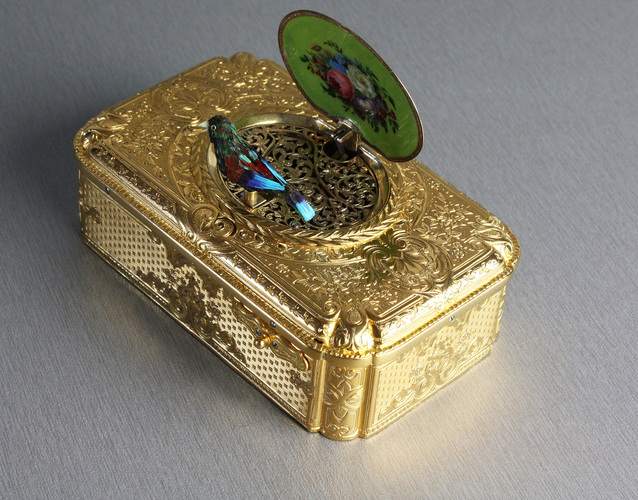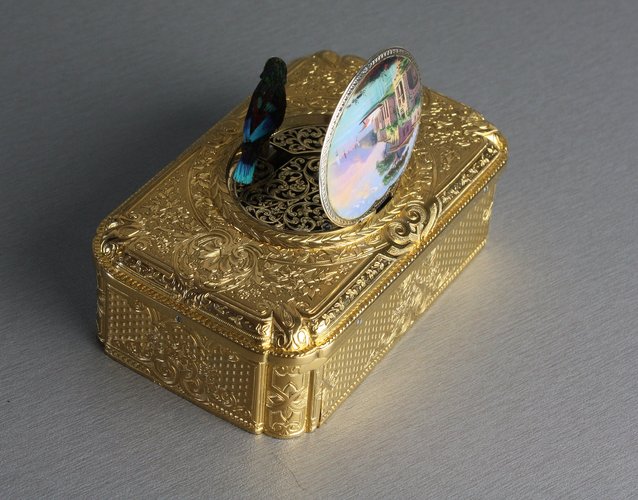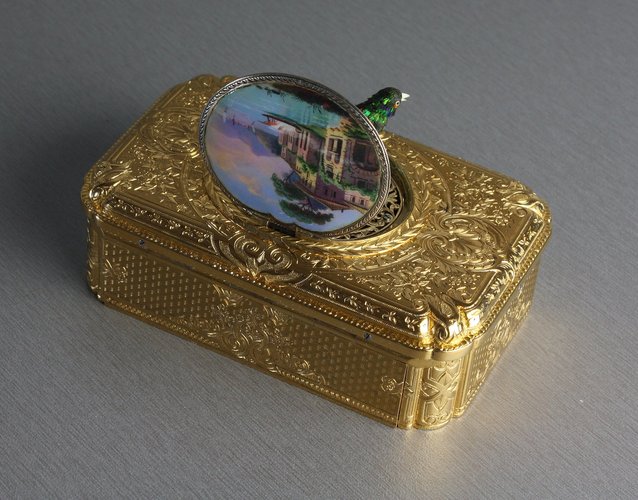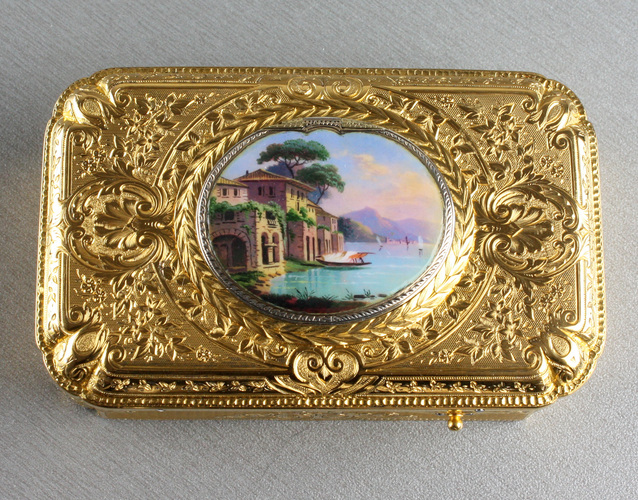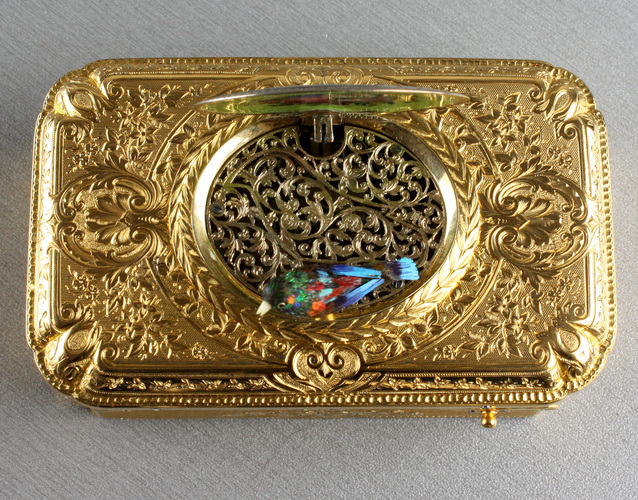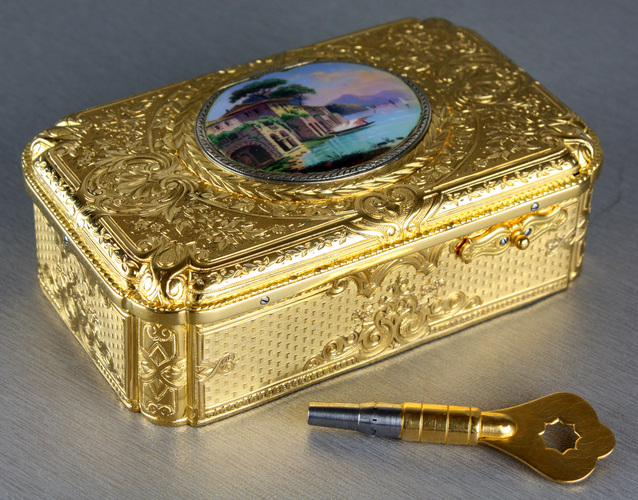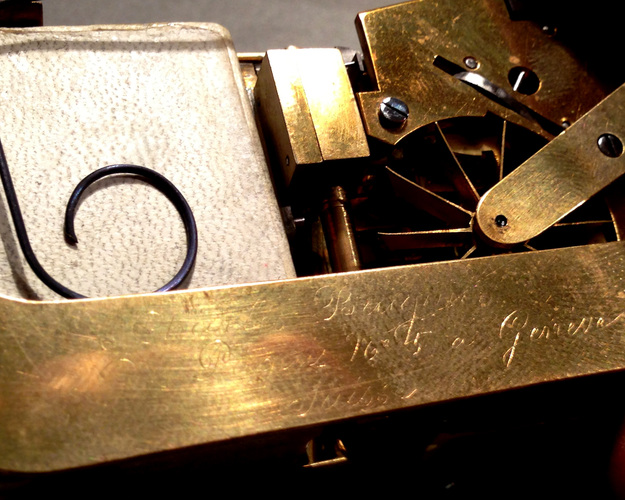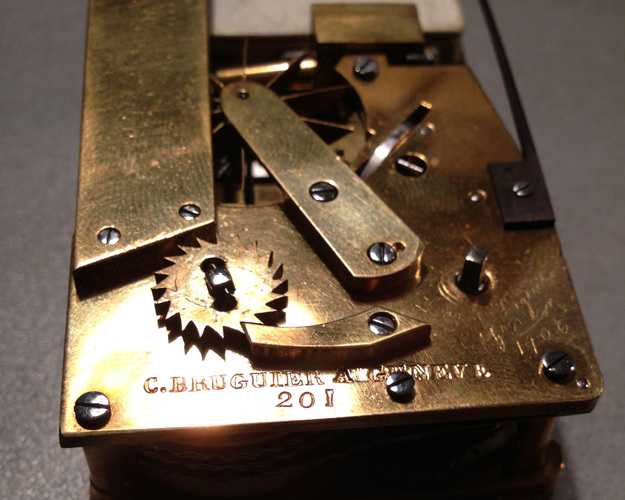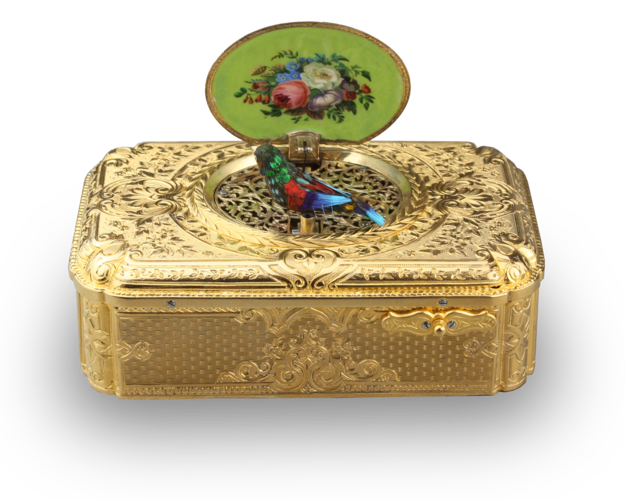
Antique silver-gilt and pictorial enamel Fusee singing bird box, with melodic notational birdsong, by Charles Bruguier
A magnificent and very fine antique silver-gilt and pictorial enamel singing bird box, with melodic notational birdsong, by Charles Bruguier,
Swiss
circa 1830
Fusee movement
Serial number 201
Bruguier magnificence and a true rarity of existence...
When wound and the start/stop slide moved to the right, the enamel lid opens and the bird within makes his appearance through the silver gilt grille, opening and closing his beak, flapping both wings, bobbing his tailfeather, turning his head and moving his body from side-to-side to paused sequential birdsong in 1-1-2-3-2-3-4 sequence from the 8-cam stack.
The zepher-skinned rectangular bellows of rectangular form, stamped C BRUGUIER Á GENEVÉ to main spring plate and stamped with his serial number 201, also signed in full in Bruguier's hand to wide single spring loafer Charles Bruguier rue des Paquis No. 5 á Genève Suisse and a repairer's mark Páquet 1909 appearing around winding spindle area on plate, blued bellows spring.
The bird with delicately layered feathered plumage in dark brown, blood red and blue, with cleverly placed green and orange iridescent highlights covering most of the torso, rises through the perfectly pierced and chased silver gilt grille.
There is a solid tooled bird-form edge to the centrum, highly polished chamfered basal,while the bird lid
interior has a beautifully painted enamel study of roses, dahlias, periwinkles, laurel leaves and ferns arranged in an oval spray on delicate olive green ground with a dot tooled border.
The top of the bird lid has a superb, finely painted view of a shore-side villa of the early 19th century period, most probably sited on the banks of Lake Como. The impressive three story dwelling has garden terraces and Norman arched windows. A boat with a sailor who collapses the sails before the mooring arcade, there are many sailing vessals on the water beyond and the green banks in the distance are eclipsed by the high mountains under the pink hued sky.
There is a shaped hinge indent with tooled detail and double laurel leaf chased frame. The main lid with the finest of tooled detail yet seen on a C. Bruguier case with twin opposing C scroll crests joined together with floral roundel. There are ivy and bud sprays to the intermediate spandrels, mitre point shaped corners with lined frames and further scrolls highlighting the centres, front and sides with central swag and crest unions, cleverly tooled to the weave line ground and edged by plain polished bands running around the entire plane. The underside with further weave line ground and the centre featuring an asymmetric cartouche with plain engraving panel, the corners with a final floral tooled finish.
A hidden, hinged key compartment holds the period and very rare ratchet key with polished steel stem and shaped brass thumb grip, start/stop slide to front-right also tooled and with the turned central stem.
size
Point of interest -
We had to undertake a gold test on this amazing box, just to double check this was silver-gilt, not gold, as the colour, richness of hue depth and quality of tooled workmanship all pointed towards this being one of a handful of the gold boxes Bruguier produced.
This silver-gilt example is the closest in every way to a gold box you are likely to see and handle, but if you do require a gold box, we will be happy to show you at least one.
The ratchet key is a delightful bonus to see, as this has a specific safety feature which helps you to look after your fusee singing bird box. As going-barrel movements are wound, as most clocks, in a clockwise direction, fusees are wound in an anti-clockwise direction and should these movements be tried in a clockwise manner, it is possible to damage the mechanism, which would require repair.
This ratchet key allows the user to wind without the risk of this happening with the teeth slipping on the key stem if a clockwise direction is attempted. It also allows the winder to use without the need to remove their fingers from the key or the key from the spindle - easy and safe.
The birdsong on this extraordinary piece is also to be noted. It is more an operatic aria than the melody heard from a bird, either a real or automaton one. Listen carefully to the notational virtues of the notes played - Mozart himself would have been delighted.... The rarer boxes by both Bruguier and Rochat used melodies from folksongs rather than simple birdsong.
| STOCK No | 1449 |
| AVAILABILITY | Sold |
| PRICE | Sold |


